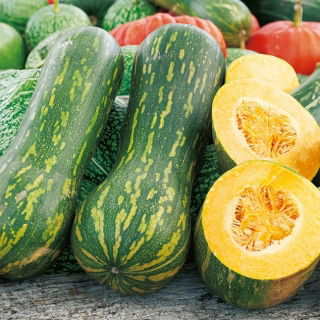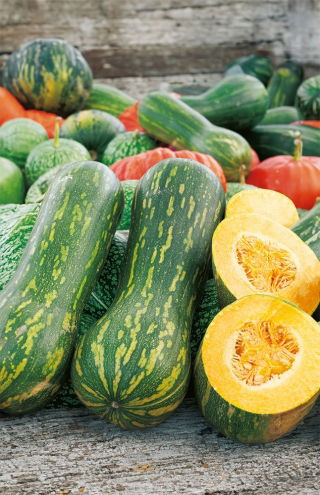Butternut Squash 'Lunga Di Napoli' is a unique variety known for its impressive, giant fruits that can weigh between 10 and even 30 kilograms. It features long, cylindrical fruits with deep orange, sweet, and aromatic flesh, making it an excellent choice for a variety of culinary uses. It tastes delightful both raw and cooked. Thanks to the high-quality seeds, you can enjoy a bountiful harvest of this mid-late variety. Investing in the cultivation of 'Lunga Di Napoli' Butternut Squash is worthwhile, with seeds available from the renowned gardening store, Garden Seeds Market. Customers appreciate the fast delivery, secure transactions, and reliability of the products offered.
Sowing
'Lunga Di Napoli' Butternut Squash requires careful soil preparation. It is recommended to sow in well-drained soil, which will provide optimal conditions for healthy plant growth. The seeds should be sown in sunny locations where they can fully develop. Regular watering is also important to support the development of young seedlings.
Sowing Depth
Butternut Squash seeds should be placed at a depth of 2-3 cm. This ensures suitable conditions for germination and protection against adverse weather conditions. Maintaining the correct sowing depth allows for strong and healthy plants.
Direct Sowing Period
When is the best time to sow 'Lunga Di Napoli' Butternut Squash seeds directly into the ground? The ideal moment is May. At this time, the soil is warm enough to promote quick germination of the seeds. It's wise to wait for stable, warm weather to provide the plants with the best start.
Sowing Period Under Cover
When to sow 'Lunga Di Napoli' Butternut Squash seeds under cover? The best time is April. Sowing seeds under cover allows for an earlier start to cultivation and better protection of young plants from cooler temperatures.
Planting Time
The best time to plant 'Lunga Di Napoli' Butternut Squash is mid-May. By then, the plants are sufficiently developed, and the weather supports their further growth. It is important to ensure proper spacing for the free development of the fruits.
Plant Spacing
The optimal spacing for this squash variety is 100x130 cm. This arrangement provides enough space for growth and development, allowing for the free expansion of the vines and ensuring adequate light and air.
Site Conditions
'Lunga Di Napoli' Butternut Squash thrives best in full sun, in fertile and well-drained soil. Appropriate fertilisation is beneficial, supporting fruit development and enhancing their final quality. Regular watering, especially during dry periods, is crucial for achieving abundant yields.
Growing Tips
The cultivation of Butternut Squash involves regular weeding and soil loosening. It is also advisable to use natural pest protection methods to maintain plant health. During the growing season, the use of organic fertilizers is recommended to support fruit development.
Harvest Period
The harvest period for 'Lunga Di Napoli' Butternut Squash is in September and October. During this time, the fruits are fully mature, and their flesh reaches peak flavour quality. Regular monitoring of the fruit's condition allows for harvest at the optimal moment.
Good to Know
'Lunga Di Napoli' Butternut Squash is resistant to most diseases, making it an excellent choice for beginner gardeners. Its fruits can be stored for a long time, allowing for their use in various dishes throughout the winter. With its richness in vitamins and minerals, Butternut Squash is not only delicious but also healthy.
Why Buy from Garden Seeds Market
Purchasing seeds from Garden Seeds Market guarantees top quality and satisfaction. The seeds are carefully tested in laboratories, ensuring high germination rates. Customers can count on fast delivery and professional service. The store enjoys positive reviews, confirming user satisfaction with their purchases. Additionally, attractive promotions are available, allowing for the purchase of seeds at favourable prices. The security of online shopping is another advantage appreciated by every customer.
The package contains 3 g of seeds. The packaging includes information on cultivation guidelines and the sowing expiry date.






